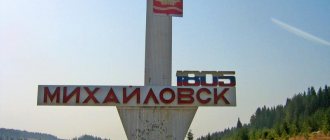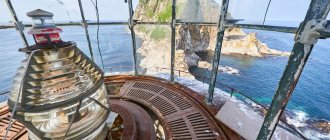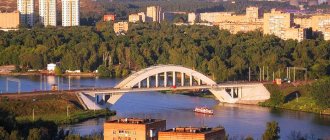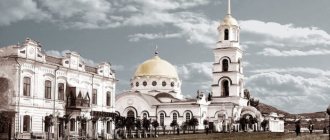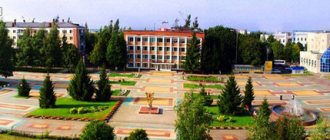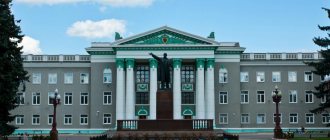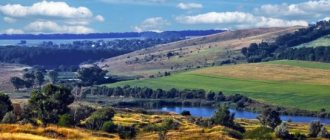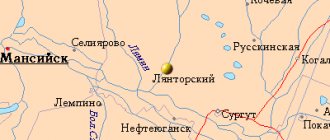This term has other meanings, see Artyomovsky urban district.
This article is about territorial formation.
For the city, see Artyom (city). Artyomovsky urban district Artyom
| Urban district | |
Geography
Artemovsky urban district is located in the south of Primorsky Krai. The district borders in the north with the Ussuriysk urban district, in the east with the Shkotovsky municipal district, in the south with the Vladivostok urban district, and in the west with the Nadezhdinsky municipal district. In the southeast, the border runs along the coastline of Ussuri Bay, in the southwest - along the coastline of Uglovoy Bay. The total length of the border of the Artemovsky urban district is approximately 121.7 km, of which 104.2 km is the land part and 17.5 km is the water part of the border[2].
The area of the urban district is 506.4 km²[4].
Current data
The number of inhabitants is 2,196,000 inhabitants. In the cities of Primorye, the environment is not good. The plight is associated with companies that handle and transport coal in large quantities. A large anthropogenic load falls on the shoulders of residents. Transshipment of coal is carried out in an open way, but the situation is changing, the regulatory authorities have taken up the solution. Now government agencies are forcing companies to build protective devices and special structures to improve the disposal of industrial waste. The number of inhabitants in the territory in 2008 was 1,789,234.
The industrial industry of the Primorsky region does not lag behind in development. More than a hundred manufacturing plants operate at full capacity in the city.
- Askold - the plant produces high-quality pipeline fittings
- Spasskcement produces cement and clinker.
- The shipyard carries out repairs of ships of all models.
- has been operating since 2016, selling construction materials.
- Primorsky Plant is a large ship repair company. The company services 80-100 ships and boats annually.
- The Pacific Fleet Rope carries out repair work on ships of the naval forces of the FSB ocean fleet.
- PJSC is a company engaged in the production of steam power protection control systems.
Brown coal deposits have been found on the territory of Primorye. In 1932, mines were designed and a powerful hydroelectric power station was built.
Migration situation
The migration situation in the urban district has a stable positive migration balance.
One of the few cities in Primorsky Krai that has a positive migration increase.[14]
| 2000 | 2001 | 2002 | 2003 | 2004 | 2005 | 2006 | 2007 | 2008 | 2009 |
| Arrived | 2 544 | 2 470 | 2 417 | 2 082 | 1 149 | ||||
| Dropped out | 2 247 | 1 650 | 1 772 | 1 642 | 1 485 | ||||
| Migr. growth | 1 040 | 820 | 645 | 440 | -336 | ||||
| 2010 | 2011 | 2012 | 2013 | 2014 | 2015[14] | 2016 | 2017 | 2018 | 2019 |
| Arrived | 1 549 | 3 141 | 3 736 | 4 137 | 5 583 | 5 832 | |||
| Dropped out | 1 476 | 2 626 | 3 981 | 4 018 | 3 904 | 4 364 | |||
| Migr. growth | 73 | 515 | 123 | 119 | 1 679 | 1 468 |
Natural movement
Number of births and deaths (absolute numbers)[14]
| 2000 | 2001 | 2002 | 2003 | 2004 | 2005 | 2006 | 2007 | 2008 | 2009 |
| Births | 1 174 | 1 179 | 1 190 | 1 217 | 1 299 | 1 277 | 1 391 | ||
| Deaths | 2 119 | 2 109 | 2 118 | 1 984 | 1 863 | 1 771 | 1 623 | ||
| E.p | -945 | -930 | -928 | -767 | -564 | -494 | -232 | ||
| 2010 | 2011 | 2012 | 2013 | 2014 | 2015[14] | 2016 | 2017 | 2018 | 2019 |
| Births | 1 362 | 1 424 | 1 488 | 1 442 | 1 488 | 1 518 | |||
| Deaths | 1 782 | 1 656 | 1 609 | 1 640 | 1 556 | 1 564 | |||
| E.p | -420 | -232 | -121 | -198 | -68 | -46 |
Natural movement per 1000 people.
| 1990 | 1991 | 1992 | 1993 | 1994 | 1995 | 1996 | 1997 | 1998 | 1999[15] |
| Fertility | 7,8 | ||||||||
| Mortality | 15,3 | ||||||||
| E.p | -7,5 | ||||||||
| Migration | |||||||||
| Total growth | |||||||||
| 2000 | 2001[15] | 2002 | 2003 | 2004 | 2005 | 2006 | 2007 | 2008 | 2009 |
| Fertility | 8,6 | 10,53 | 10,56 | 10,65 | 10,87 | 11,59 | 11,42 | 12,41 | |
| Mortality | 17,7 | 19,01 | 18,89 | 18,96 | 17,72 | 16,63 | 15,84 | 14,48 | |
| E.p | -9,1 | -8,84 | -8,33 | -8,31 | -6,85 | -5,04 | -4,42 | -2,07 | |
| Migration | 10,03 | 8,85 | 9,21 | 5,76 | 2,09 | 4,63 | |||
| Total growth | 1,70 | 0,54 | 2,36 | 0,72 | -2,33 | 2,56 | |||
| 2010 | 2011 | 2012 | 2013 | 2014 | 2015 | 2016 | 2017 | 2018 | 2019 |
| Fertility | 12,16 | 12,68 | 13,20 | 12,71 | 13,23 | 13,21 | |||
| Mortality | 15,91 | 14,75 | 14,30 | 14,66 | 13,78 | 13,61 | |||
| E.p | -3,75 | 2,07 | -1,10 | -1,95 | -0,55 | -0,40 | |||
| Migration | 3,22 | 4,59 | -3,27 | 1,06 | 15,35 | 13,62 | |||
| Total growth | -0,53 | 2,52 | -3,27 | -0,89 | 14,80 | 13,22 |
Compound
The urban district and the city of regional subordination include 6 settlements[2][3]:
| № | Locality | Type of settlement | Population |
| 1 | Artyom | city, administrative center | ↗105 338[1] |
| 2 | Knevichi | village | ↗4845[7] |
| 3 | Krolevtsy | village | ↗1008[7] |
| 4 | Deer | village | ↗1246[7] |
| 5 | Surazhevka | village | ↗1944[7] |
| 6 | Clear | village | ↘415[7] |
Countries and cities of the World
Most major cities in the world have their own telephone code. To simplify and systematize, international telephone numbers are also used to reach a specific country. Therefore, to call any city in the world, you must first dial the international country code, and then that city.
A telephone code is unique only within its own country. And besides, some small towns are combined into groups with the same prefixes.
To find out information about the country, follow the link.
And about the new functions of our site: now you have the opportunity to study satellite maps not only of Russian cities, but also regions, as well as all countries of the world (follow the link above).
Notes
- ↑ 1234
www.gks.ru/free_doc/doc_2016/bul_dr/mun_obr2016.rar Population of the Russian Federation by municipalities as of January 1, 2016 - ↑ 123
[artemokrug.ru/ustav.php Charter of the Artyomovsky urban district] - ↑ 12
[docs.cntd.ru/document/494218997 Law “On the administrative-territorial structure of the Primorsky Territory”] - [www.zspk.gov.ru/municipal/info/sbornik.html Collection “Municipalities of the Primorsky Territory”]
- [www.perepis2002.ru/ct/doc/1_TOM_01_04.xls All-Russian Population Census 2002. Volume. 1, table 4. Population of Russia, federal districts, constituent entities of the Russian Federation, districts, urban settlements, rural settlements - regional centers and rural settlements with a population of 3 thousand or more]. [www.webcitation.org/65AdCU0q3 Archived from the original on February 3, 2012].
- [www.gks.ru/bgd/regl/B09_109/IssWWW.exe/Stg/d01/tabl-21-09.xls Number of permanent population of the Russian Federation by cities, urban-type settlements and districts as of January 1, 2009]. Retrieved January 2, 2014. [www.webcitation.org/6MJmu0z1u Archived from the original on January 2, 2014].
- ↑ 123456
[www.primstat.ru/VPN2010/webpages/chislNas.mht Population of urban districts, municipal districts, urban and rural settlements, urban settlements, rural settlements. All-Russian Population Census 2010 (as of October 14, 2010). Primorsky Krai]. Retrieved August 31, 2013. [www.webcitation.org/6HISX870K Archived from the original on June 11, 2013]. - www.gks.ru/dbscripts/munst/munst05/DBInet.cgi?pl=8112027 Primorsky Krai. Resident population estimate as of January 1
- [www.gks.ru/free_doc/doc_2012/bul_dr/mun_obr2012.rar Population of the Russian Federation by municipalities. Table 35. Estimated resident population as of January 1, 2012]. Retrieved May 31, 2014. [www.webcitation.org/6PyOWbdMc Archived from the original on May 31, 2014].
- [www.gks.ru/free_doc/doc_2013/bul_dr/mun_obr2013.rar Population of the Russian Federation by municipalities as of January 1, 2013. - M.: Federal State Statistics Service Rosstat, 2013. - 528 p. (Table 33. Population of urban districts, municipal districts, urban and rural settlements, urban settlements, rural settlements)]. Retrieved November 16, 2013. [www.webcitation.org/6LAdCWSxH Archived from the original on November 16, 2013].
- [www.gks.ru/free_doc/doc_2014/bul_dr/mun_obr2014.rar Table 33. Population of the Russian Federation by municipalities as of January 1, 2014]. Retrieved August 2, 2014. [www.webcitation.org/6RWqP50QK Archived from the original on August 2, 2014].
- [www.gks.ru/free_doc/doc_2015/bul_dr/mun_obr2015.rar Population of the Russian Federation by municipalities as of January 1, 2015]. Retrieved August 6, 2015. [www.webcitation.org/6aaNzOlFO Archived from the original on August 6, 2015].
- [demoscope.ru/weekly/pril.php Censuses of 1939,1959,1970,1979,1989,2002,2010]. Population censuses 1939,1959,1970,1979,1989,2002,2010
. - ↑ 1 2 3 4
[primstat.gks.ru/wps/wcm/connect/rosstat_ts/primstat/ru/statistics/population/ Official statistics \ Population].
Official statistics\Population
. - ↑ 1 2
[www.mojgorod.ru/primor_kraj/artjom/ Indicators of the municipality].
Municipal indicators
.
Migration
Migration movement for 2022. In 2022, 34,000 residents arrived in the Primorsky Territory, almost 60% were Russians who arrived from abroad - 13,900. -33,400 left the Primorsky Territory, the flow coefficient is 0.7. 2022 was productive. The level of the number of visitors has exceeded the 2022 attendance threshold. From 2015 to 2018, the number of residents decreased by 15,000. Primorsky Krai always remains in first place in seafood production.
Forecast. According to young people and economic experts, the region is located far from the center and has no prospects for business development. Migration outflow occurs either gradually or abruptly. The influx of migrants comes from the shores of the Japanese islands. Residents from neighboring countries (Japan) are actively involved in fishing, trade, and scientific and technological research in the Primorsky Territory. The indigenous inhabitants of Primorye immigrate to remote regions of Russia; the climatic conditions and microclimate are not suitable for most residents.
An excerpt characterizing the Artyomovsky urban district (Primorsky Territory)
- Go ahead, Zakhar! - Nikolai shouted to his father’s coachman in order to have a chance to overtake him on the road. The old count's troika, in which Dimmler and the other mummers sat, squealed with their runners, as if frozen to the snow, and rattled a thick bell, moved forward. The ones attached to them pressed against the shafts and got stuck, turning out the strong and shiny snow like sugar. Nikolai set off after the first three; The others made noise and screamed from behind. At first we rode at a small trot along a narrow road. While we were driving past the garden, shadows from bare trees often lay across the road and hid the bright light of the moon, but as soon as we left the fence, a diamond-shiny snowy plain with a bluish sheen, all bathed in a monthly glow and motionless, opened up on all sides. Once, once, a bump hit the front sleigh; in the same way, the next sleigh and the next were pushed and, boldly breaking the chained silence, one after another the sleighs began to stretch out. - A hare's trail, a lot of tracks! – Natasha’s voice sounded in the frozen, frozen air. – Apparently, Nicholas! - said Sonya's voice. – Nikolai looked back at Sonya and bent down to take a closer look at her face. Some completely new, sweet face, with black eyebrows and mustaches, looked out from the sables in the moonlight, close and far. “It was Sonya before,” thought Nikolai. He looked at her closer and smiled. – What are you, Nicholas? “Nothing,” he said and turned back to the horses. Having arrived on a rough, large road, oiled with runners and all covered with traces of thorns, visible in the light of the moon, the horses themselves began to tighten the reins and speed up. The left one, bending its head, twitched its lines in jumps. The root swayed, moving its ears, as if asking: “should we start or is it too early?” – Ahead, already far away and ringing like a thick bell receding, Zakhar’s black troika was clearly visible on the white snow. Shouting and laughter and the voices of those dressed up were heard from his sleigh. “Well, you dear ones,” Nikolai shouted, tugging on the reins on one side and withdrawing his hand with the whip. And only by the wind that had become stronger, as if to meet it, and by the twitching of the fasteners, which were tightening and increasing their speed, was it noticeable how fast the troika flew. Nikolai looked back. Screaming and screaming, waving whips and forcing the indigenous people to jump, the other troikas kept pace. The root steadfastly swayed under the arc, not thinking of knocking it down and promising to push it again and again when necessary. Nikolai caught up with the top three. They drove down some mountain and onto a widely traveled road through a meadow near a river. “Where are we going?” thought Nikolai. - “It should be along a slanting meadow. But no, this is something new that I have never seen. This is not a slanting meadow or Demkina Mountain, but God knows what it is! This is something new and magical. Well, whatever it is!” And he, shouting at the horses, began to go around the first three. Zakhar reined in the horses and turned around his face, which was already frozen to the eyebrows. Nikolai started his horses; Zakhar, stretching his arms forward, smacked his lips and let his people go. “Well, hold on, master,” he said. “The troikas flew even faster nearby, and the legs of the galloping horses quickly changed. Nikolai began to take the lead. Zakhar, without changing the position of his outstretched arms, raised one hand with the reins. “You’re lying, master,” he shouted to Nikolai. Nikolai galloped all the horses and overtook Zakhar. The horses covered the faces of their riders with fine, dry snow, and near them there was the sound of frequent rumblings and the tangling of fast-moving legs and the shadows of the overtaking troika. The whistling of runners through the snow and women's squeals were heard from different directions. Stopping the horses again, Nikolai looked around him. All around was the same magical plain soaked through with moonlight with stars scattered across it. “Zakhar shouts for me to take a left; why go left? thought Nikolai. Are we going to the Melyukovs, is this Melyukovka? God knows where we are going, and God knows what is happening to us - and it is very strange and good what is happening to us.” He looked back at the sleigh. “Look, he has a mustache and eyelashes, everything is white,” said one of the strange, pretty and alien people with a thin mustache and eyebrows. “This one, it seems, was Natasha,” thought Nikolai, and this one is m me Schoss; or maybe not, but I don’t know who this Circassian with the mustache is, but I love her.” -Aren't you cold? - he asked. They did not answer and laughed. Dimmler shouted something from the back sleigh, probably funny, but it was impossible to hear what he was shouting. “Yes, yes,” the voices answered laughing. - However, here is some kind of magical forest with shimmering black shadows and sparkles of diamonds and with some kind of enfilade of marble steps, and some kind of silver roofs of magical buildings, and the piercing squeal of some animals. “And if this really is Melyukovka, then it’s even stranger that we were traveling God knows where, and came to Melyukovka,” thought Nikolai. Indeed, it was Melyukovka, and girls and lackeys with candles and joyful faces ran out to the entrance. - Who it? - they asked from the entrance. “The counts are dressed up, I can see it by the horses,” answered the voices. Pelageya Danilovna Melyukova, a broad, energetic woman, wearing glasses and a swinging hood, was sitting in the living room, surrounded by her daughters, whom she tried not to let get bored. They were quietly pouring wax and looking at the shadows of the emerging figures when the footsteps and voices of visitors began to rustle in the hall. Hussars, ladies, witches, payassas, bears, clearing their throats and wiping their frost-covered faces in the hallway, entered the hall, where candles were hastily lit. The clown - Dimmler and the lady - Nikolai opened the dance. Surrounded by screaming children, the mummers, covering their faces and changing their voices, bowed to the hostess and positioned themselves around the room. - Oh, it’s impossible to find out! And Natasha! Look who she looks like! Really, it reminds me of someone. Eduard Karlych is so good! I didn't recognize it. Yes, how she dances! Oh, fathers, and some kind of Circassian; right, how it suits Sonyushka. Who else is this? Well, they consoled me! Take the tables, Nikita, Vanya. And we sat so quietly! - Ha ha ha!... Hussar this, hussar that! Just like a boy, and his legs!... I can’t see... - voices were heard. Natasha, the favorite of the young Melyukovs, disappeared with them into the back rooms, where they needed cork and various dressing gowns and men's dresses, which through the open door received the naked girlish hands from the footman. Ten minutes later, all the youth of the Melyukov family joined the mummers. Pelageya Danilovna, having ordered the clearing of the place for the guests and refreshments for the gentlemen and servants, without taking off her glasses, with a restrained smile, walked among the mummers, looking closely into their faces and not recognizing anyone. Not only did she not recognize the Rostovs and Dimmler, but she also could not recognize either her daughters or her husband’s robes and uniforms that they were wearing. -Whose is this? - she said, turning to her governess and looking into the face of her daughter, who represented the Kazan Tatar. - It seems like someone from Rostov. Well, Mr. Hussar, what regiment do you serve in? – she asked Natasha. “Give the Turk, give the Turk some marshmallows,” she said to the bartender who was serving them: “this is not prohibited by their law.” Sometimes, looking at the strange but funny steps performed by the dancers, who had decided once and for all that they were dressed up, that no one would recognize them and therefore were not embarrassed, Pelageya Danilovna covered herself with a scarf, and her entire corpulent body shook from the uncontrollable, kind, old lady’s laughter . - Sashinet is mine, Sashinet is that! - she said. After Russian dances and round dances, Pelageya Danilovna united all the servants and gentlemen together, in one large circle; They brought a ring, a string and a ruble, and general games were arranged. An hour later, all the suits were wrinkled and upset. Cork mustaches and eyebrows were smeared across sweaty, flushed and cheerful faces. Pelageya Danilovna began to recognize the mummers, admired how well the costumes were made, how they suited especially the young ladies, and thanked everyone for making her so happy. The guests were invited to dine in the living room, and the courtyard was served in the hall.
Artyom
The first Russian settlements
Once upon a time, the place where the city of Artyom is located today was a swampy valley covered with dense taiga. People did not settle here for a long time because of the swamps and the ubiquitous midges.
In 1891, near the bay of the Amur Bay, peasants resettled from the western regions of Russia founded the village of Uglovoye, which became the first permanent Russian settlement in these places. A few years later, other villages appeared nearby - Krolevets and Knevichi, founded in 1896 and named so in memory of the places where the settlers came from. An 1896 report on the resettlement of peasants testifies: “The settlers formed four new settlements this year, including the villages ... Knevichi and Krolevets in the valley of the Batalyanza River”
. From this document it is known that 13 peasant families from the Krolevets district and 5 families from the Novozybkov district of the Chernigov province settled in Krolevets. During the second wave of resettlement, at least 11 families arrived in these places, including: Domnitsky, Krivenko, Nazarenko, Oleshko, Sushchenko, Oleinik, Khrushch and others.
From the end of 1907, the name Batalyanza appeared in church books; from January 1, 1908, it was already used in parallel with the official name Surazhevka. The village received this name from the Surazhevsky district of the Chernigov province, where almost all of its founders previously lived. All of them came from the village of Kozhany (Vereshchak volost of Surazhevsky district), these are the families of Foki Borisenko, Anton Koryavchenko, Nikita Golik (Golikova) nicknamed Shchun and others.
Currently, a huge greenhouse farm operates in Surazhevka - the experimental production farm of the Federal State Unitary Enterprise "Dalnevostochnoe" was established on March 15, 1982, which is the largest greenhouse complex in the Primorsky Territory; vegetable crops are grown here. The greenhouse plant's capacity is 4,020 tons of vegetables per year, including 660 tons of open-ground vegetables and 3,360 tons of protected soil vegetables.
One of the oldest villages on the territory of the Artyomovsky urban district is the village of Oleniy, the year of foundation of which is not precisely established, but it is known that the village was founded no earlier than 1887 and no later than 1912.
The construction of the Ussuri section of the Trans-Siberian Railway was of great importance for the development of the first settlements located on the territory of the modern city of Artyom. In 1907, the Khodasevich farm was founded, located in the area of the former “9th Versta” station on the Suchanskaya railway. Grigory Zakharovich Khodasevich, who settled in these places in 1907, was the first Russian to set up his farm next to the Korean fans.
Zybunnye mines and mining village
In the area of the 9th verst of the Suchan narrow-gauge railway in 1910, rich coal seams were discovered that came to the surface. In 1913, a large Vladivostok entrepreneur, merchant of the 1st guild Skidelsky Leib Shimanovich (Leonty Semenovich), became the owner of three Zybunny mines in this place. The total value of his fortune at that time was estimated at 8.6 million rubles - an astronomical amount for those times. L. Sh. Skidelsky died in 1916, passing on to his heirs a fortune of 9.5 million rubles. In 1922, one of the mines in the valley of the Lake Keys (today the center of the city of Artyom is located here) was named after Yakov Leontyevich Skidelsky, one of the sons of Leib Shimanovich.
In January 1913, the first plot was staked out among the marsh swamps, called zybuny by local residents. Three mines were laid at the 9th kilometer. In the fall of 1913, construction of the first mine began. Life Skidelsky ordered that, simultaneously with the laying of the mines, the construction of a settlement on the ruts should begin. The coal mines began to be called “Zybunnye”. This was the beginning of the history of the future city of Artyom.
After the revolution
By decree of the Far Eastern Revolutionary Committee and the decision of the Arbitration Court in May 1923, all enterprises, real estate and financial assets belonging to the Skidelsky family were nationalized. At a meeting of workers, held in the same 1923, it was decided to name the village and mine after the revolutionary and party leader Artyom (Fyodor Andreevich Sergeev). Since 1924, the mine was officially given the name “Artemovsk State Coal Mines.”
In 1925, the Artyomovsky mines became part of the Primugol trust, created on October 1. The mine developed rapidly. Since the nationalization of the mines of L. Sh. Skidelsky, three new mines were built and in 1927 five mines were operating here. However, mechanization was minimal, in 1927–1930. It was planned to install a heavy cutting machine in mine No. 3, in addition, eight light cutting machines, and purchase seven electric manual machines. It was planned to use two light-type and two heavy-type electric locomotives in the mines, as well as a loading machine and electric drills. The cost of mechanization was supposed to be 170–180 thousand rubles.
In 1929, mines No. 6 and No. 2-2 bis were put into operation, in 1931 – No. 2/5, No. 4. In 1930, the first jackhammers, core winches, electric drills, scrapers, conveyors, electric locomotives and a compressor began to be used in mine work.
By 1931, Artyom became the main supplier of coal in Primorye. On November 7, 1931, mine No. 3-ts was founded and put into operation in September 1938 with a design capacity of 1,500 thousand tons per year. In 1934, the first tons of coal were produced at the mine. This mine, renamed “Far Eastern” before the war, became the forge of Artyom’s miners; longwalls and roadheaders were first introduced there.
In 1932, construction began on the Artemovskaya State District Power Plant, the first regional power plant in the Far East. Komsomol members who arrived from the European regions of the Soviet Union worked hard at the construction site. After the news of the death of Sergei Mironovich Kirov at the end of 1934, it was decided to name the power plant in his honor. By 1935, the main building for two turbogenerators and three boilers was ready. November 6, 1936 was the birthday of the state district power station; on this day the turbine generator was launched.
By 1934, Artem became a mining center with six mechanized mines. By September 1935, mine No. 6-6 bis was put into operation, in 1936 - No. 3-ts.
With the construction of the Ugolnaya – Suchan broad-gauge railway in 1935 and the commissioning of a state district power station, the coal industry had conditions for rapid development.
In 1913, the history of the central electromechanical workshops (CEMM) began - one of the oldest enterprises in the city of Artyom. Then, in 1913, mines were built, called “Zybunny mines”. The first workshops occupied a wooden dugout-type building, built by the entrepreneur Skidelsky to service the copies that were then still under construction. Blacksmithing work was carried out here, cast iron and bronze were melted, and later the workshops began servicing lifting installations in mines and pits, making wedges, picks, crowbars, shovels, sledgehammers, and repairing steam pumps.
With the beginning of the use of electricity in mines in 1929, an electrical shop was organized in which electric motors were repaired. Until 1935, all equipment in the mines was repaired by workshop mechanics; there were no mechanics in the mines.
In 1935, 50 people worked in the electromechanical workshops; their equipment included a lathe and a drilling machine, driven manually. During the war, work began in a special workshop created during these years; according to military orders, stabilizers for aerial bombs, housings for grenades, metal structures for anti-aircraft installations were made here, and the chassis of tanks was repaired.
Artyom as a city, Soviet period
By the decision of the Presidium of the Supreme Council of the RSFSR on October 26, 1938, the village of Artyom was transformed into a city.
In the 1930s In the city of Artyom, the Ozernye Klyuchi airport began to be built, and in 1937 the first planes began to take off from it. In 1956, the TU-104 passenger aircraft ushered in the era of jet aviation, as a result of which the large Vladivostok airport was created on the basis of the Knevichi airfield. Over the course of 5 years (1959–1964), a whole complex of ground facilities was built here, which made it possible to begin receiving aircraft on a regular basis, while the volume of passenger traffic increased significantly.
In 1938, the Far Eastern mine was put into operation with a design capacity of 1,500 thousand tons per year. For high achievements in 1943, the mine staff was awarded the Red Banner of the State Defense Committee. In the post-war years, the mine staff continued to successfully fulfill production tasks. On January 22, 1971, by Decree of the Presidium of the Supreme Soviet of the USSR, the mine was awarded the Order of the Badge of Honor. During the entire period of operation, the mine produced 37.3 million tons of coal. In May 1997, work at the Far Eastern mine was stopped and the mine was liquidated.
Mine No. 8 (the future Amurskaya) was founded in 1939; it was built from 1946 to 1954. On December 31, 1954, the mine with a design capacity of 450,000 tons was put into operation. For the successful construction of the 8th mine, the head of mining operations F. Timintsev was awarded the Order of the Red Banner of Labor, and the foreman of the miners A. Ziganshin was awarded the title Hero of Socialist Labor. Mine No. 8 was renamed Amurskaya in 1971.
In 1937, in the area of 9 kilometers, mine No. 7 bis (“Ozernaya”) was founded, which was put into operation in 1941 (design production capacity 300,000 tons per year). Ozernaya, which developed the western part of the Artyomovskoye coal deposit, became the first coal mining enterprise to begin the process of closing particularly unprofitable mines. In 1941, the Podgorodnenskaya mine was also put into operation (design capacity 120,000 tons per year).
Bright pages in the history of the coal industry of the region were the years of the Eighth Five-Year Plan (1966–1970) - the years of the highest labor enthusiasm. The team of V.F. Zuban mastered the narrow-cut combines LGD-2 and 2K-52, and in December 1966 this team set a regional record, producing 22,217 tons of coal in a month. For outstanding services and mastery of new technology, V. F. Zuban was awarded the title of Hero of Socialist Labor.
In the early 1940s. construction of mine No. 11 (“Primorskaya”) began, but during the war years construction work was stopped and resumed only in 1955. In 1961, the mine, located in the central part of the Artyomovskoye deposit, was put into operation (design production capacity 410,000 tons per year). In 1991, the volume of coal production at Primorskaya began to decline, falling in 1996 to 44.8 thousand tons (with an established 120 thousand tons). Due to low technical and economic indicators and the impossibility of profitable operation, it was decided to liquidate the Primorskaya mine as particularly unprofitable (liquidation was completed in 1999).
On the basis of mine No. 6-6, founded in 1931, put into operation in 1935 and closed on January 1, 1975 due to the development of coal reserves in the mine field, the Shkotovskaya mine was created, consisting of 3 units : the Smolyaninovskaya mine, the Smolyaninovsky open-pit mine and the exploration mine at the Central site.
Subsequently, the Shkotovskaya mine was renamed the Artyom mine. It was part of the Primorskugol production association; coal was transported from the face to the surface at the mine using belt conveyors. The use of highly mechanized equipment made it possible in 1982 to achieve a record production of 770 thousand tons. In 1986, reconstruction began at the mine, and in 1991 the first launch complex was commissioned. But already in 1995, with changes in the economic and political situation in the country, funding for unprofitable enterprises was reduced, which resulted in a reduction in production and a deterioration in economic indicators. On April 1, 1998, coal mining was stopped, on April 17, liquidation work began, and on July 1, 1999, the liquidation of mine workings was completed.
Currently, the Dalnevostochnaya, Imeni Artem, Ozernaya, Primorskaya, and Podgorodnenskaya mines are closed. The Amurskaya mine, with its exploration of high-quality coal and a 35-year operating prospect, has also not survived.
After the reconstruction of the central electromechanical workshops in 1955, metal support for mining began to be produced here in 1958, the boiler-forge shop was put into operation the following year, the mechanical assembly shop was put into operation in 1961, a year later the foundry shop was reconstructed, steel casting.
In 1970, a specialized underground section was created and began to operate, carrying out installation, dismantling and repair of mining equipment in mines.
Today, CEMM has an extensive machine park of over 90 units. Artemovskiye TSEMM carries out repairs of heavy quarry equipment and mining equipment of the Primorskugol production association, spare parts, metal structures, metal fastenings, small-scale mechanization mechanisms, roof supports, non-standard equipment are manufactured here, steel, cast iron, bronze and aluminum castings are carried out, as well as Common consumption goods.
The development of coal mining and the construction of the village, which eventually turned into a city, resulted in the dynamic development of the construction industry in the city of Artyom. The first and largest enterprise in the city was the Dalshakhtostroy trust, formed in 1938. It was created with the aim of developing the infrastructure of the coal industry in the Primorsky Territory. The trust united 14 divisions, whose forces built coal mines and mines, factories and factories, state farms, housing and social and cultural facilities. In 1972, SU-27 (Construction Directorate 27) was created, which over the next 30 years erected and commissioned numerous buildings and structures.
In 1956, in accordance with the decision of the Ministry of Construction Materials and the project developed by the Giprostroymaterialy Institute (Moscow), the construction of the reinforced concrete products plant-3 with a design capacity of 70 thousand cubic meters began. meters of reinforced concrete products per year for the needs of civil and industrial construction. Along with the construction of the plant, the village of Zavodskoy grew. The area near the village of Krolevtsy, where the village of Zavodskoy is located today, was a flat area for a long time. During the war, a training airfield was based here. With the start of construction of the plant and village in 1956, builders from all over the Soviet Union began to come to the construction site. The first streets appear in the Green District. The Mikhailovskaya broiler poultry farm is being built in the village. In a relatively short time, modern manufacturing enterprises grew up on an empty site.
In 1958, the concrete goods plant-4 with a capacity of 5,000 cubic meters was put into operation. meters of precast reinforced concrete per year, during that period intensive construction of Artyom began, and therefore there was an urgent need for precast reinforced concrete.
The city's energy sector also developed intensively. Along with the increase in production and supply of electricity, the problem of district heating was gradually solved. Between 1982 and 1985. Turbines No. 5 and 6 were reconstructed; in 1984, Artemovskaya State District Power Plant was transferred to the category of thermal power plant. Since its launch, Artemovskaya CHPP has been a basic enterprise in the field of local energy.
In 1957, the Artyomovsk piano factory “Primorye” produced its first products. Over the next decade, a number of new enterprises opened in Artyom: a porcelain factory, furniture and carpet factories. Founded in 1964, the Artyomovsky porcelain factory became the first-born of the porcelain industry of the Far East; in March 1965, it produced the first products, which over the years became popular not only among the townspeople, they were in high demand throughout the region, took prizes and received awards at various exhibitions and competitions. In 1961, the Primorsky Furniture Factory was founded. In October 1968, its first workshop opened and the first products were produced.
In 1939, the first bakery was put into operation in Artyom. In 1974, a bakery appeared in the city, in which two workshops operated - a bakery and a confectionery.
In 1973, near the north-eastern borders of the city of Artyom, on the territory of a picturesque forest, the construction of a poultry farm began, the largest in the Far East, equipped with German equipment with a capacity of 550 thousand laying hens with a productivity of 132 million eggs and 12.5 thousand centners of poultry meat.
On March 15, 1982, the Dalnevostochnoe pilot production enterprise (EPF) was established, which became the largest greenhouse complex in the Primorsky Territory. The Far Eastern Department of the Research Institute of Vegetable Farming became the basis for the creation in 1988 of the Primorsky Vegetable Experimental Station, which was tasked with numerous tasks of scientific vegetable growing.
The city in the 1990s and 2000s
In the early 1990s. many enterprises in the city of Artyom began to experience difficulties and closed. Sewing, knitting, and carpet factories ceased to exist. The Artyomovsk piano factory also closed before reaching its 50th anniversary.
In May 1992, Vladivostok Airport received international status and today it receives flights from more than thirty Russian and foreign airports.
There are 20 large enterprises in the city, the Artyomovsky bakery, Vladivostok Avia, a city dairy plant, a meat processing plant, Vtorchermet, the Dalnevostochny state farm, SU-27, Demetra, PMS-220, OJSC MK-67 operate stably. , ArtemCHP. The production volume of the city of Artyom is dominated by: the construction industry (about 30%), the fuel industry (about 24%), woodworking (about 19%), and the food industry (about 14%). On the basis of the Primorsky Furniture Factory, a number of enterprises are steadily developing, of which the most famous are “Primorsky Veneer” and “PriMFLes”, equipped with modern high-performance lines of foreign production.
The Ussuriyskaya poultry farm, along with its main activity - the production of eggs, has also been engaged in the cultivation of broiler meat since October 1997, when the Mikhailovskaya poultry farm joined it. CJSC Demetra is the main supplier of agricultural products for preschool institutions and orphanages. JSC Artemovsky, founded back in 1957, produces livestock and vegetable products. The Teplichny state farm was transformed into a closed joint-stock company Nadezhda.
In 2003, the products of the Artyomovsk City Dairy Plant - fermented baked milk and sour cream "Artyomka" - were included in the list of 100 best products of the Primorsky Territory.
